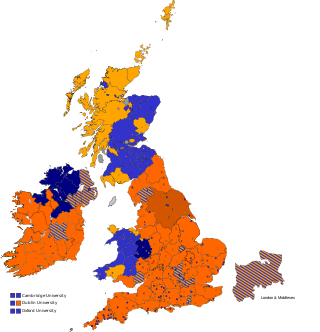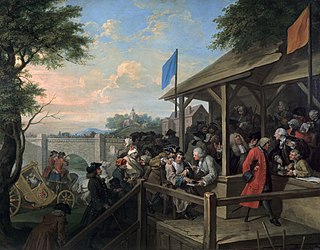Related Research Articles
Forty-shilling freeholders were those who had the parliamentary franchise to vote by virtue of possessing freehold property, or lands held directly of the king, of an annual rent of at least forty shillings, clear of all charges.

Yorkshire was a constituency of the House of Commons of the Parliament of England from 1290, then of the Parliament of Great Britain from 1707 to 1800 and of the Parliament of the United Kingdom from 1801 to 1832. It was represented by two Members of Parliament, traditionally known as Knights of the Shire, until 1826, when the county benefited from the disfranchisement of Grampound by taking an additional two members.
Worcestershire was a county constituency of the House of Commons of the Parliament of England then of the Parliament of Great Britain from 1707 to 1800 and of the Parliament of the United Kingdom from 1801 to 1832. It was represented until 1832 by two Members of Parliament traditionally referred to as Knights of the Shire. It was split then into two two-member divisions, for Parliamentary purposes, Worcestershire Eastern and Worcestershire Western constituencies.
Wiltshire was a constituency of the House of Commons of England from 1290 to 1707, of the House of Commons of Great Britain from 1707 to 1800 and of the House of Commons of the United Kingdom from 1801 to 1832. It was represented by two Members of Parliament (MPs), elected by the bloc vote system.
Sussex was a constituency of the House of Commons of the Parliament of England then of the Parliament of Great Britain from 1707 to 1800 and of the Parliament of the United Kingdom from 1801 to 1832. It was represented by two Knights of the Shire, elected by the bloc vote system.
Bedfordshire was a United Kingdom Parliamentary constituency, which elected two Members of Parliament to the House of Commons of England from 1295 until 1707, then the House of Commons of Great Britain until 1801 and the House of Commons of the United Kingdom until 1885 when it was divided into two constituencies under the Redistribution of Seats Act 1885.
Derbyshire is a former United Kingdom Parliamentary constituency. It was a constituency of the House of Commons of the Parliament of England then of the Parliament of Great Britain from 1707 to 1800 and of the Parliament of the United Kingdom from 1801 to 1832. It was represented by two Knights of the Shire.
Berkshire was a parliamentary constituency in England, represented in the House of Commons of the Parliament of England until 1707, then of the Parliament of Great Britain from 1707 to 1800 and of the Parliament of the United Kingdom from 1801 to 1885. The county returned two knights of the shire until 1832 and three between 1832 and 1885.

Lancashire was a county constituency of the House of Commons of the Parliament of England from 1290, then of the Parliament of Great Britain from 1707 to 1800, and of the Parliament of the United Kingdom from 1801 to 1832. It was represented by two Members of Parliament, traditionally known as Knights of the Shire until 1832.

Newton was a parliamentary borough in the county of Lancashire, in England. It was represented by two Members of Parliament in the House of Commons of the Parliament of England from 1559 to 1706 then of the Parliament of Great Britain from 1707 to 1800 and of the Parliament of the United Kingdom from 1801 until its abolition in 1832.

West Riding of Yorkshire was a parliamentary constituency in England from 1832 to 1865. It returned two Members of Parliament (MPs) to the House of Commons of the Parliament of the United Kingdom.
Warwickshire was a parliamentary constituency in Warwickshire in England. It returned two Members of Parliament (MPs), traditionally known as knights of the shire, to the House of Commons of England, Great Britain and House of Commons of the Parliament of the United Kingdom, elected by the bloc vote system.
The Parliamentary representation by historic counties is summarised in this article, with links to the articles about the representation of each of the historic counties in the House of Commons of the Parliaments of England, Great Britain (1707-1800) and the United Kingdom.

Oxfordshire was a county constituency of the House of Commons of the Parliament of England then of the Parliament of Great Britain from 1707 to 1800 and of the Parliament of the United Kingdom from 1801 to 1885. It was represented by two Members of Parliament. In 1832 this was increased to three Members of Parliament. The constituency was abolished in 1885, being split into three single member divisions.
Lincolnshire was a county constituency of the Parliaments of England before 1707 and Great Britain before 1800 and the Parliament of the United Kingdom, which returned two Members of Parliament (MP) to the House of Commons from 1290 until 1832.
Kent was a parliamentary constituency covering the county of Kent in southeast England. It returned two "knights of the shire" to the House of Commons by the bloc vote system from the year 1290. Members were returned to the Parliament of England until the Union with Scotland created the Parliament of Great Britain in 1708, and to the Parliament of the United Kingdom after the union with Ireland in 1801 until the county was divided by the Reform Act 1832.
Staffordshire was a county constituency of the House of Commons of the Parliament of England then of the Parliament of Great Britain from 1707 to 1800 and of the Parliament of the United Kingdom from 1801 to 1832. It was represented by two Members of Parliament until 1832.
Hertfordshire was a county constituency covering the county of Hertfordshire in England. It returned two Knights of the Shire to the House of Commons of England until 1707, then to the House of Commons of Great Britain until 1800, and to the House of Commons of the Parliament of the United Kingdom from 1801 until 1832. The Reform Act 1832 gave the county a third seat with effect from the 1832 general election.
Suffolk was a County constituency of the House of Commons of the Parliament of England from 1290 to 1707, then of the Parliament of Great Britain from 1707 to 1800 and of the Parliament of the United Kingdom from 1801, which returned two Members of Parliament (MPs) to the House of Commons until 1832, when it was split into two divisions.
Until the Reform Act 1832, there were eight constituencies in the Parliament of England and its successors related to the Cinque Ports. The cinque port constituencies were slightly different from parliamentary boroughs. The 1832 Act abolished most such distinctions, and disfranchised some of the cinque ports as rotten.
References
Citations
- 1 2 Tomlins, Thomas Edlyne; Granger, Thomas Colpitts (1835). "Knights of the Shire". The Law-dictionary, Explaining the Rise Progress and Present State of the British Law. Vol. II (4th ed.). London: Clarke. p. 10. Retrieved 7 April 2017.
- ↑ Roskell, J. S. (1993). "1386-1421; VI. Electoral Practice". History of Parliament Online. Retrieved 7 April 2017.
- ↑ Blackstone, William (1765). Commentaries on the Laws of England. Vol. 2. p. 68. Retrieved 7 April 2017.; citing 23 Hen.6 c.15 [recte 14] "that the Knights of the Shires for the Parliament hereafter to be chosen, shall be notable Knights of the same Counties for the which they shall [so] be chosen, or otherwise such notable Esquires, Gentlemen [of birth] of the same Counties, as shall be able to be Knights; and no Man to be such Knight which standeth in the Degree of a Yeoman and under."
- 1 2 Engel, Matthew (30 April 2010). "Last of the old knights of the shires". The Financial Times. Archived from the original on 24 January 2015. Retrieved 4 November 2013.
{{cite news}}: CS1 maint: bot: original URL status unknown (link) - ↑ Given-Wilson, Chris (2004). Chronicles: the writing of history in medieval England. Continuum International Publishing Group. p. 175. ISBN 978-1-85285-358-7. OCLC 59259407.
- ↑ Davies, R.G.; Denton, J.H.; Roskell, J.S. (1981). The English Parliament in the Middle Ages. Manchester University Press. p. 39. ISBN 978-0-7190-0833-7. OCLC 7681359.
- ↑ Schama, Simon (2003). A History of Britain 1: 3000 BC-AD 1603 At the Edge of the World? (Paperback 2003 ed.). London: BBC Worldwide. p. 158. ISBN 978-0-563-48714-2.
- ↑ Seymour, Charles (1915). Electoral reform in England and Wales; the development and operation of the parliamentary franchise, 1832–1885. New Haven: Yale University Press. p. 11.
Sources
- The text of the 1832 Reform Act
- Chronological Table of the Statutes: Part 1 1235-1962 (The Stationery Office Ltd 1999)
- Electoral Reform in England and Wales, by Charles Seymour (David & Charles Reprints 1970)
- The Statutes: Revised Edition, Vol. I Henry III to James II (printed by authority in 1876)
- The Statutes: Second Revised Edition, Vol. XVI 1884-1886 (printed by authority in 1900)